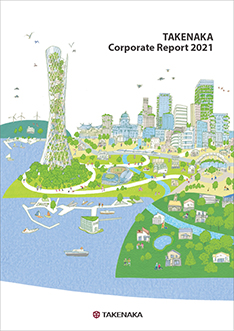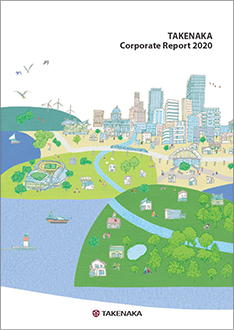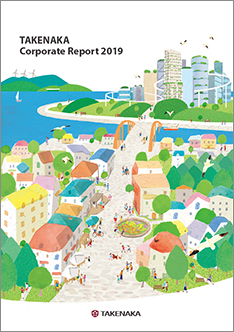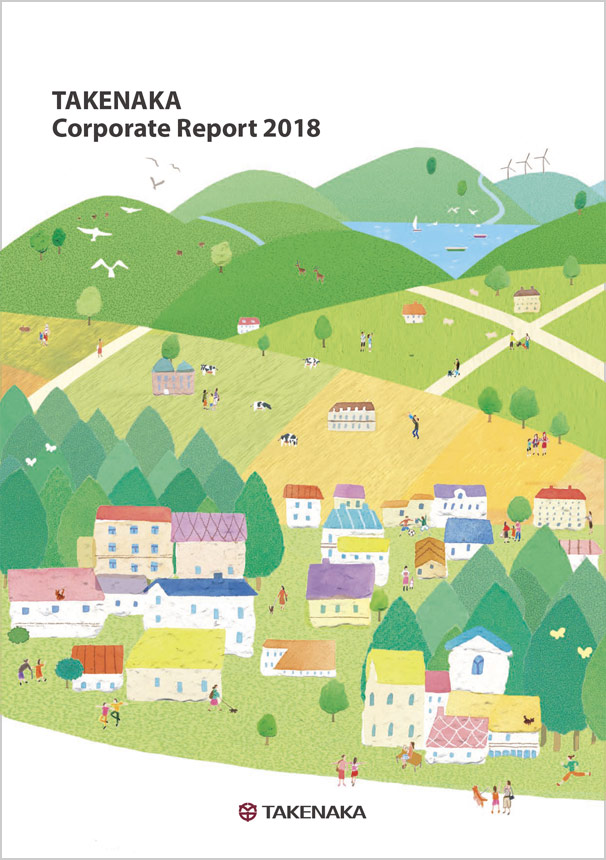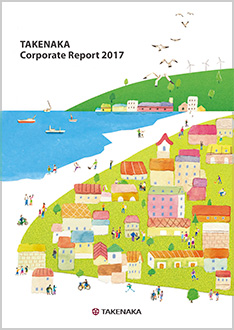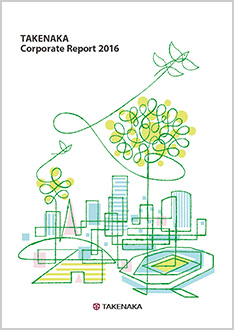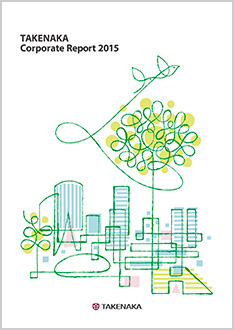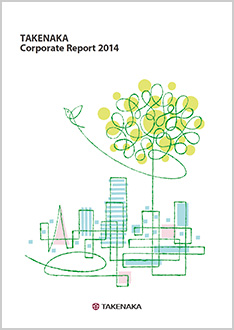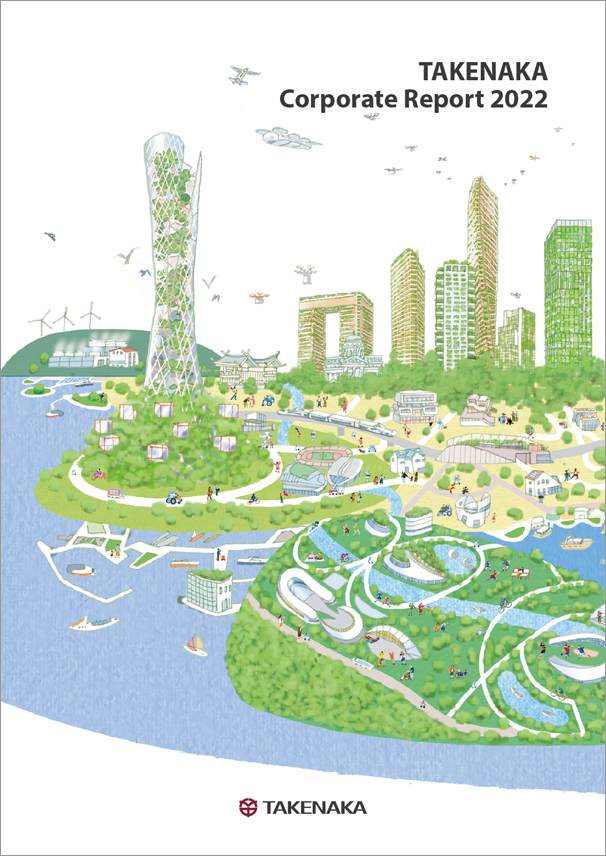
TAKENAKA Corporate Report
We have compiled this Takenaka Corporate Report 2023 for the purpose of presenting the Takenaka Group CSR Vision and describing the projects undertaken by our corporate group as a whole with maximum clarity. Its contents primarily comprise details related to activities conducted by Takenaka Corporation. Contents, case examples and data that could not be covered in the report due to space constraints will be featured on the Takenaka Corporation website.
This report integrates our corporate brochure (introductory overview of our businesses) and sustainability report (CSR activity report), which were formerly issued as separate publications. It also seeks to obtain the full understanding of our stakeholders by incorporating our medium-term management plan as well as our principal financial and nonfinancial data in order to present the business operations implemented by our group on a global scale.
For further information located on our website, click the marks found in this report.

WEB publication contents
CSR Contents, case examples and data that cannot be covered in the report due to space constraints are featured.
External Perspectives
ADACHI Naoki, PhD CEO, Response Ability, Inc.
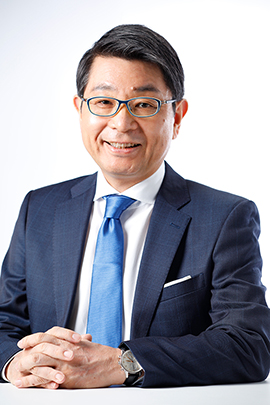
PhD in plant ecology from the Graduate School of Science,the University of Tokyo
After working for the National Institute for Environmental Studies (NIES) and the Forest Research Institute Malaysia (FRIM), he launched his own career, providing companies with guidance for establishing sustainable supply chains and sustainable management strategies, and sustainable branding. He serves as Executive Director for the Japan Business Initiative for Biodiversity (JBIB), Sustainability Producer for Sustainable Brands Japan, advisor for the Wild Bird Society of Japan and other posts. He is also a member of the Informal Advisory Group for the UN Convention on Biological Diversity and various committees in government ministries. His writings include Capitalizing on Biodiversity —a Sustainable Resource Strategy.
It is the third year in a row for me to review the TAKENAKA Corporate Report from 2020. In this report I was most impressed by WITH HARAJUKU project (pages 13-14), presented as an example of sustainable works. The building, which consists of a complex structure that shows continuity with the surrounding greenery, seems to imply a new ecosystem in urban areas. I felt like visiting it after reading. I also found the Building Communication System (BCS) (page 22) designed to create smart buildings very attractive. It shows that enhancing comfort levels while reducing the building's environmental impact is possible not to mention future extensions and updates. I think this indicates the direction of possible evolution of architecture.
All the various initiatives described in the report present Takenaka's solutions to major objectives. This year being the final year of the 2020-2022 Action Plan for a Sustainable Society, the report details the achievements under the Plan (pages 27-41). Although the initiatives generally show fairly good results,achievement levels differ in some targets. Work Style and Productivity Reform (pages 34-35) appears to be struggling to achieve its targets. With the Revised Labor Standards Law, scheduled to come into force for the construction industry in April 2024, it is an urgent and critical issue for business continuity amid the growing shortage of skilled construction workers. Takenaka has been working on the issue for many years, and the report also presents its efforts to create a better work environment for diverse people, including women, and to raise productivity. Notwithstanding, targets such as two days off per week at construction sites appear to present challenges that cannot be easily resolved amid established practices in the industry. In fact, I felt a bit anxious about the significantly low level of achievement against other targets. On the other hand, Takenaka's initiatives in pursuing greater efficiency in construction and creating new values through the development of the Takenaka Advanced Construction Integration (pages 11-12) are a very good approach to take. I look forward to this system bringing results in the future.
Similarly, from the various descriptions given in the report, I can see various technologies, not limited to digital technology, being actively applied and Takenaka's aggressive stance on development through collaboration. The proof of its diligent efforts can be found in Technical Innovation and Cocreation (page 34), in which targets have been achieved for all issues.
The targets for Sustainable Architecture and Urban Creation (pages 29-31), an area that is fundamental and material for Takenaka, have been achieved for most issues. Since this is the foundation of value creation for Takenaka, I look forward to accelerated action and expansion in the scope of activities. The same is true for Harmonization with the Environment (pages 32-34), where most targets have been achieved.
In face of the growing expectations for the environmental performance of buildings, however, we anticipate that the growth in demand will require more aggressive target setting and action in the future. As seen in the announcement at last year's UNFCCC COP27, the global temperature rise is likely to exceed 1.5° under the current nationally determined contributions (NDC). Certainly, it is not an issue that can be addressed solely by a single company like Takenaka, I would like to see Takenaka use its position as a leader in the construction industry to impose on itself lofty goals and to push for greater speed in implementation.
The latest report also describes the new major objectives, indicators and targets that are defined for action in 2023 and later, in addition to the results of the three-year plan (pages 37-38). The major objectives that were reviewed are reasonable and must be addressed by the construction industry. Notwithstanding, I wonder whether these issues is enough to be recognized and covered by Takenaka. This stems from my hopes that Takenaka will develop ambitious solutions from a long-term perspective in addressing fundamental issues that Takenaka and the rest of the industry failed to confront squarely but that must be addressed for the future of the world.
To be specific, I believe that in the future the construction industry must not only pursue greater performance for single buildings but also use such buildings to introduce sustainability in community design and functions. I believe greater attention should be paid to the impact on the landscape, in terms of the impact of the building on society. There are demands for a significant extension to building lifespan in the future as a means to reduce the environmental impact. Doing this will also impact the landscape of the community over a longer period of time and will also mean greater responsibility for construction. In other words, I believe that examining the role of buildings as key elements in providing the functions and forming the landscape of sustainable urban areas will become major objectives.
Another point that requires attention is Nature Positive, the goal for the world to be achieved by 2050 that was adopted by CBD COP15 convened in December 2022. We are entering an era that seeks restoration not only of ecosystems in nature but also those in urban areas.
Further, it is an age of ecosystem development, not only one that is limited to increasing the volume of greenery but one that will build urban areas in harmony with nature in the truest sense, while making effective use of the functions of greenery. Mobilizing its all-round capabilities covering the full spectrum from design to construction, Takenaka has created beautiful landmarks that have served as symbols for their respective ages. Does this mean that, with the shift toward restoration and in symbiosis with nature, urban areas are to be created centering around super long-life landmarks that will remain for the next several centuries? Such a grand vision and view of the world based on this vision will become major objectives in the future.
The report elaborates on initiatives that Takenaka has organized and executed for the development of a sustainable society, and all of them have produced impressive results. As mentioned earlier in relation to climate change, the creation of a sustainable society simply through the pursuit of the current policy and its implementation seems difficult at this speed. What the reader would like to know is what Takenaka is thinking regarding this matter. We would like to know what Takenaka wishes to do regarding buildings and urban areas and its view of the world in the future. For this reason, I look forward to a clear presentation of Takenaka's view on what is being planned to achieve true sustainability, in addition to the achievements it had made thus far.

